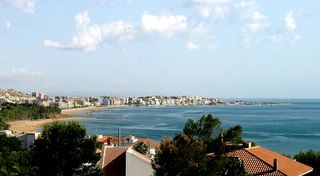
Crotone is a city and comune in Calabria. Founded c. 710 BC as the Achaean colony of Kroton, it was known as Cotrone from the Middle Ages until 1928, when its name was changed to the current one. In 1992, it became the capital of the newly established Province of Crotone. As of August 2018, its population was about 65,000.

Cortlandt is a town in Westchester County, New York located at the northwest edge of the county, at the eastern terminus of the Bear Mountain Bridge. The town includes the villages of Buchanan and Croton-on-Hudson.

Croton-on-Hudson is a village in Westchester County, New York, United States. The population was 8,070 at the 2010 census. It is located in the town of Cortlandt as part of New York City's northern suburbs. The village was incorporated in 1898.

Dragon's blood is a bright red resin which is obtained from different species of a number of distinct plant genera: Croton, Dracaena, Daemonorops, Calamus rotang and Pterocarpus. The red resin has been in continuous use since ancient times as varnish, medicine, incense, and dye.

Croton is an extensive flowering plant genus in the spurge family, Euphorbiaceae. The plants of this genus were described and introduced to Europeans by Georg Eberhard Rumphius. The common names for this genus are rushfoil and croton, but the latter also refers to Codiaeum variegatum. The generic name comes from the Greek κρότος, which means "tick" and refers to the shape of the seeds of certain species.
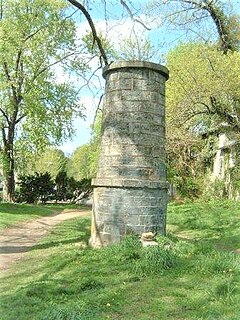
The Croton Aqueduct or Old Croton Aqueduct was a large and complex water distribution system constructed for New York City between 1837 and 1842. The great aqueducts, which were among the first in the United States, carried water by gravity 41 miles (66 km) from the Croton River in Westchester County to reservoirs in Manhattan. It was built because local water resources had become polluted and inadequate for the growing population of the city. Although the aqueduct was largely superseded by the New Croton Aqueduct, which was built in 1890, the Old Croton Aqueduct remained in service until 1955.
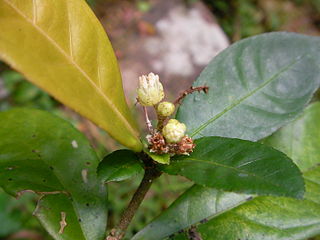
Croton hanceiBenth., the Hong Kong croton, is a shrub or small tree, a species of Croton which is endemic to Tsing Yi Island, Hong Kong. In Hong Kong, it is listed in the book Rare and precious Plants of Hong Kong.

The Muscoot Reservoir is a reservoir in the New York City water supply system in northern Westchester County, New York, located directly north of the village of Katonah. Part of the system's Croton Watershed, it is 25 miles north of the City. It was constructed at the beginning of the 19th century by impounding the Croton River, a tributary of the Hudson River.

The New Croton Reservoir is a reservoir in Westchester County, New York, part of the New York City water supply system lying approximately 22 miles (35 km) north of New York City. It is the collecting point for water from all reservoirs in the Croton Watershed.
A chemical peel is a technique used to improve and smooth the texture of the skin. Facial skin is mostly treated, and scarring can be improved. Chemical peels are intended to remove the outermost layers of the skin. To accomplish this task, the chosen peel solution induces a controlled injury to the skin. Resulting wound healing processes begin to regenerate new tissues. The dead skin eventually peels off. The regenerated skin is usually smoother and less wrinkled than the old skin. Some types of chemical peels can be purchased and administered without a medical license, however people are advised to seek professional help from a dermatologist or plastic surgeon on a specific type of chemical peel before a procedure is performed.

The Croton River is a river in southern New York with three principal tributaries: the West Branch, Middle Branch, and East Branch. Their waters, all part of the New York City water supply system, join downstream from the Croton Falls Reservoir. Together, their waters and the reservoirs linked to them represent the northern half of the New York City water system's Croton Watershed.
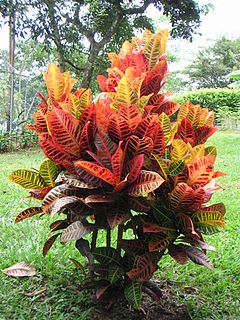
Codiaeum variegatum is a species of plant in the genus Codiaeum, which is a member of the family Euphorbiaceae. It was described by Carl Linnaeus in 1753. It is native to Indonesia, Malaysia, Australia, and the western Pacific Ocean islands, growing in open forests and scrub.
Sybaris on the Traeis was an ancient city of Magna Grecia situated on the Traeis river, now known as the Trionto. It shares its name with the original city of Sybaris which was destroyed in 510 BC. Its former inhabitants built a new city, Thurii, not far from the site of Sybaris. This new colony was founded together with other Greek settlers in 446/445 BC. Soon a conflict arose between the two groups and most of the Sybarites were killed by the other Greek colonists of Thurii. The Sybarites who managed to flee then founded Sybaris on the Traeis a short time after 444 BC. The city was destroyed by the Bruttii not long after their emergence as an ethnic group in 356/355 BC.
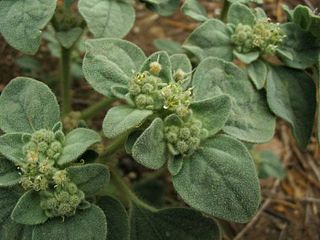
Croton setiger is a species of plant known as turkey mullein and dove weed. It is native to most of the western United States and northwest Mexico. It has naturalized elsewhere, including parts of Australia. It is sometimes spelled Croton setigerus and was formerly known as Eremocarpus setigerus.

The Jacqueline Kennedy Onassis Reservoir, also known as Central Park Reservoir, is a decommissioned reservoir in Central Park in the borough of Manhattan, New York City, stretching from 86th to 96th Streets. It covers 106 acres (43 ha) and holds over 1,000,000,000 US gallons (3,800,000 m3) of water.
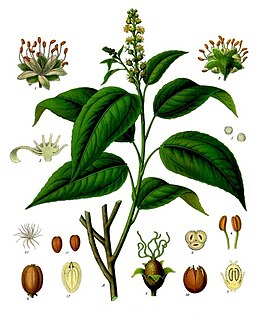
Croton tiglium, known as purging croton, is a plant species in the family Euphorbiaceae. C. tiglium is also called jamaal gota in India.
Croton barahonensis is a species of plant of the genus Croton and the family of Euphorbiaceae, present in the Dominican Republic on the island of Hispaniola.
Croton lawianus is a species of the family Euphorbiaceae native to the Nilgiri Hills of Tamil Nadu, India.

Croton gratissimus, is a tropical African shrub or small tree with corky bark, growing to 8 m and belonging to the family of Euphorbiaceae or spurges. Young twigs are slender and angular and covered in silver and rust-coloured scales.














